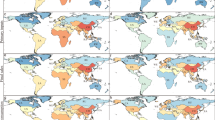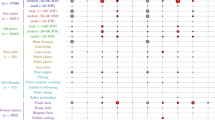Abstract
Chlorinated and brominated polycyclic aromatic hydrocarbons (Cl/BrPAHs) are emerging organic pollutants that pose severe risks to both the natural environment and public health. However, the limited understanding of their global emission sources and levels hinders effective control measures. Here we present a comprehensive global inventory and source attribution analysis of Cl/BrPAH emissions from 11 key industrial sectors. By integrating emission data with machine learning models, we estimate that global industrial Cl/BrPAH emissions in 2018 were 5,143 kg (94.3% ClPAHs and 5.7% BrPAHs) across 184 countries. Emission hotspots, in terms of total estimated Cl/BrPAH emissions, were concentrated in Oceania, East Asia and Latin America, collectively accounting for over 66% of the global total emissions. Iron ore sintering was identified as the largest industrial source (86.1% of total emissions). These findings can facilitate policy-making and the development of mitigation strategies for Cl/BrPAH emissions, and eventually contribute to greener industries.
This is a preview of subscription content, access via your institution
Access options
Access Nature and 54 other Nature Portfolio journals
Get Nature+, our best-value online-access subscription
$32.99 / 30 days
cancel any time
Subscribe to this journal
Receive 12 digital issues and online access to articles
$119.00 per year
only $9.92 per issue
Buy this article
- Purchase on SpringerLink
- Instant access to full article PDF
Prices may be subject to local taxes which are calculated during checkout





Similar content being viewed by others
Data availability
The minimum dataset necessary to interpret, verify and extend the work is provided in Supplementary Information. Geospatial maps (Figs. 3 and 4 and Supplementary Figs. 3–6 and 10) were generated using ArcGIS 10.2 on the basis of open-access vector data from GADM (https://gadm.org/). The machine learning datasets of this study are provided in Supplementary Data as a tabular-format spreadsheet, including the datasets required for modelling and prediction. The final modelling data, including Supplementary Data 1 (modeling data), Supplementary Data 2 (forecast data) and Supplementary Data 3 (output data of Monte Carlo simulation), are also provided with this paper. Furthermore, the source dataset for Figs. 1–5 are available via Zenodo at https://doi.org/10.5281/zenodo.15869972.
Code availability
Code used for this study is available via GitHub at https://github.com/123yangyueyao/XGBoost-Forecast-Model-of-XPAHs.
References
Allen, J. A. et al. Covalent binding of polycyclic aromatic compounds to mitochondrial and nuclear DNA. Nature 287, 244–245 (1980).
2023 Annual Air Quality Monitoring Report (Hamilton Air Monitoring Network, 2023).
Air Quality in Ireland 2020 (Environmental Protection Agency, 2020).
2022 Ambient Air Monitoring Network Review (Michigan Department of Environment, Great Lakes, and Energy, 2022).
UK Air Information Resource—PAH Monitoring Data (DEFRA, 2008); https://uk-air.defra.gov.uk/data/pahs
Clean Air Act (US Government Printing Office, 1970; amended 1990).
European Union Directive 2004/107/EC relating to arsenic, cadmium, mercury, nickel and polycyclic aromatic hydrocarbons in ambient air. Off. J. Eur. Union 23, 3–16 (2005).
Law of the People’s Republic of China on the Prevention and Control of Atmospheric Pollution (Standing Committee of the National People’s Congress, 1987; amended 2018).
European Union Directive 2010/75/EU of the European Parliament and of the Council on industrial emissions (integrated pollution prevention and control). Off. J. Eur. Union 334, 17–119 (2010).
Liu, G. et al. Atmospheric emission of PCDD/Fs, PCBs, hexachlorobenzene, and pentachlorobenzene from the coking industry. Environ. Sci. Technol. 43, 9196–9201 (2009).
Method 1613B: Tetra- through Octa-Chlorinated Dioxins and Furans by Isotope Dilution HRGC/HRMS (US Environmental Protection Agency, 1994).
European Union Directive (EU) 2016/2284 of the European Parliament and of the Council on the reduction of national emissions of certain atmospheric pollutants. Off. J. Eur. Union L344, 1–31 (2016).
Stockholm Convention on Persistent Organic Pollutants (POPs) (United Nations Environment Programme, 2024).
Jin, R. et al. Chlorinated and brominated polycyclic aromatic hydrocarbons: sources, formation mechanisms, and occurrence in the environment. Prog. Energy Combust. Sci. 76, 100803 (2020).
Ohura, T. et al. Spatial distribution and exposure risks of ambient chlorinated polycyclic aromatic hydrocarbons in Tokyo Bay area and network approach to source impacts. Environ. Pollut. 232, 367–374 (2018).
Vuong, Q. T. et al. Seasonal variation and gas/particle partitioning of atmospheric halogenated polycyclic aromatic hydrocarbons and the effects of meteorological conditions in Ulsan, South Korea. Environ. Pollut. 263, 114592 (2020).
Jin, R. et al. Atmospheric deposition of chlorinated and brominated polycyclic aromatic hydrocarbons in central Europe analyzed by GC-MS/MS. Environ. Sci. Pollut. Res. 28, 61360–61368 (2021).
Zhang, L. H. et al. Photochemical behavior of benzo[a]pyrene on soil surfaces under UV light irradiation. J. Environ. Sci. 18, 1226–1232 (2006).
Tillner, J. et al. Simultaneous determination of polycyclic aromatic hydrocarbons and their chlorination by-products in drinking water and the coatings of water pipes by automated solid-phase microextraction followed by gas chromatography-mass spectrometry. J. Chromatogr. A 1315, 36–46 (2013).
Wang, X. et al. Determination of chlorinated polycyclic aromatic hydrocarbons in water by solid-phase extraction coupled with gas chromatography and mass spectrometry. J. Sep. Sci. 39, 1742–1748 (2016).
Ohura, T. et al. Spatial and vertical distributions of sedimentary halogenated polycyclic aromatic hydrocarbons in moderately polluted areas of Asia. Environ. Pollut. 196, 331–340 (2015).
Liu, Q. et al. Simultaneous determination of forty-two parent and halogenated polycyclic aromatic hydrocarbons using solid-phase extraction combined with gas chromatography-mass spectrometry in drinking water. Ecotoxicol. Environ. Saf. 181, 241–247 (2019).
Ohura, T. et al. Aryl hydrocarbon receptor-mediated effects of chlorinated polycyclic aromatic hydrocarbons. Chem. Res. Toxicol. 20, 1237–1241 (2007).
Liu, Y. et al. Priority organic pollutant monitoring inventory and relative risk reduction potential for solid waste incineration. Environ. Sci. Technol. 58, 18356–18367 (2024).
Fernando, S. et al. Identification of the halogenated compounds resulting from the 1997 plastimet inc. fire in Hamilton, Ontario, using comprehensive two-dimensional gas chromatography and (ultra) high resolution mass spectrometry. Environ. Sci. Technol. 48, 10656–10663 (2014).
Ieda, T. et al. Environmental analysis of chlorinated and brominated polycyclic aromatic hydrocarbons by comprehensive two-dimensional gas chromatography coupled to high-resolution time-of-flight mass spectrometry. J. Chromatogr. A 1218, 3224–3232 (2011).
Wang, Q. et al. Effects of characteristics of waste incinerator on emission rate of halogenated polycyclic aromatic hydrocarbon into environments. Sci. Total Environ. 625, 633–639 (2018).
Yang, Y. et al. Discovery of significant atmospheric emission of halogenated polycyclic aromatic hydrocarbons from secondary zinc smelting. Ecotoxicol. Environ. Saf. 238, 113594 (2022).
Jin, R. et al. Secondary copper smelters as sources of chlorinated and brominated polycyclic aromatic hydrocarbons. Environ. Sci. Technol. 51, 7945–7953 (2017).
Xu, Y. et al. Chlorinated and brominated polycyclic aromatic hydrocarbons from metallurgical plants. Environ. Sci. Technol. 52, 7334–7342 (2018).
Wang, Z. et al. Enhancing scientific support for the Stockholm Convention’s implementation: an analysis of policy needs for scientific evidence. Environ. Sci. Technol. 56, 2936–2949 (2022).
Young, P. J. et al. The Montreal Protocol protects the terrestrial carbon sink. Nature 596, 384–388 (2021).
EMEP/EEA Air Pollutant Emission Inventory Guidebook (European Environment Agency, 2019).
Toolkit for Identification and Quantification of Releases of Dioxins, Furans and Other Unintentional POPs Under Article 5 of the Stockholm Convention (UNEP, 2013); https://toolkit.pops.int/
Yang, L. et al. Occurrence of chlorinated and brominated polycyclic aromatic hydrocarbons from electric arc furnace for steelmaking. Environ. Pollut. 294, 118663 (2022).
Jin, R. et al. Congener-specific determination of ultratrace levels of chlorinated and brominated polycyclic aromatic hydrocarbons in atmosphere and industrial stack gas by isotopic dilution gas chromatography/high resolution mass spectrometry method. J. Chromatogr. A 1509, 114–122 (2017).
Tang, L. et al. Iron and steel industry emissions and contribution to the air quality in China. Atmos. Environ. 237, 117668 (2020).
Aarhaug, T. A. et al. Aluminium primary production off-gas composition and emissions: an overview. JOM 71, 2966–2977 (2019).
Liu, W. et al. Environmental impact of typical zinc smelting that implements solid waste collaborative utilization in China. Int. J. Life Cycle Assess. 27, 1316–1333 (2022).
Wu, G. et al. State of art control of dioxins/unintentional POPs in the secondary copper industry: a review to assist policy making with the implementation of the Stockholm Convention. Emerg. Contam. 6, 235–249 (2020).
Zhao, C. et al. Atmospheric emissions of hexachlorobutadiene in fine particulate matter from industrial sources. Nat. Commun. 15, 4737 (2024).
Wang, P. et al. Long-term implications of municipal solid waste (MSW) classification on emissions of PCDD/Fs and other pollutants: five-year field study in a full-scale MSW incinerator in southern China. J. Clean. Prod. 440, 140848 (2024).
Watari, T. et al. Efficient use of cement and concrete to reduce reliance on supply-side technologies for net-zero emissions. Nat. Commun. 13, 4158 (2022).
Cottom, J. W. et al. A local-to-global emissions inventory of macroplastic pollution. Nature 633, 101–108 (2024).
Wan, Y. et al. Exploring the influence of block environmental characteristics on land surface temperature and its spatial heterogeneity for a high-density city. Sustain. Cities Soc. 118, 105973 (2025).
Fiedler, H. et al. The Stockholm convention: a tool for the global regulation of persistent organic pollutants. Chem. Int. 41, 4–11 (2019).
Qian, L. H. An empirical study on the relationship between urbanization, transportation infrastructure, industrialization and environmental degradation in China, India and Indonesia. Environ. Dev. Sustain. https://doi.org/10.1007/s10668-024-05773-1 (2024).
Balakrishnan, V. S. Clean air, climate targets, and respiratory health in Europe. Lancet Respir. Med. 13, e12–e13 (2024).
World Bank Country and Lending Groups (World Bank, 2018); https://datahelpdesk.worldbank.org/knowledgebase/articles/906519-world-bank-country-and-lending-groups
Acknowledgements
We acknowledge the financial support provided by the National Natural Science Foundation of China (grant no. 22106030), ‘Pioneer’ and ‘Leading Goose’ R&D Program of Zhejiang (grant nos. 2025C02218 and 2023C03157) and the Research Funds of Hangzhou Institute for Advanced Study, UCAS (grant nos. 2023HIAS-Y014 and 2024HIAS-Y005).
Author information
Authors and Affiliations
Contributions
R.J. conceived and supervised the project. Y.Y. performed the experiments, analysed the data and wrote the paper. Y.L. and Z.Y. contributed to sample analysis and interpretation. R.J., Y.Y., Y.M., G.L. and M.Z. discussed the results. R.J., G.Z., B.L., Y.M. and G.L. collected the samples. All authors revised and approved the final paper.
Corresponding author
Ethics declarations
Competing interests
The authors declare no competing interests.
Peer review
Peer review information
Nature Sustainability thanks Guofeng Shen, Huizhong Shen and Quang Vuong for their contribution to the peer review of this work. Peer reviewer reports are available.
Additional information
Publisher’s note Springer Nature remains neutral with regard to jurisdictional claims in published maps and institutional affiliations.
Supplementary information
Supplementary Information
Supplementary Discussion 1–7, Notes 1–6, Figs. 1–12, Tables 1–10 and References.
Supplementary Data
1, modelling data—no names; 2, modelling data; 3, forecast data—no names; and 4, forecast data.
Rights and permissions
Springer Nature or its licensor (e.g. a society or other partner) holds exclusive rights to this article under a publishing agreement with the author(s) or other rightsholder(s); author self-archiving of the accepted manuscript version of this article is solely governed by the terms of such publishing agreement and applicable law.
About this article
Cite this article
Yang, Y., Liu, Y., Yu, Z. et al. Global industrial emissions of chlorinated and brominated polycyclic aromatic hydrocarbons. Nat Sustain (2025). https://doi.org/10.1038/s41893-025-01656-z
Received:
Accepted:
Published:
DOI: https://doi.org/10.1038/s41893-025-01656-z



